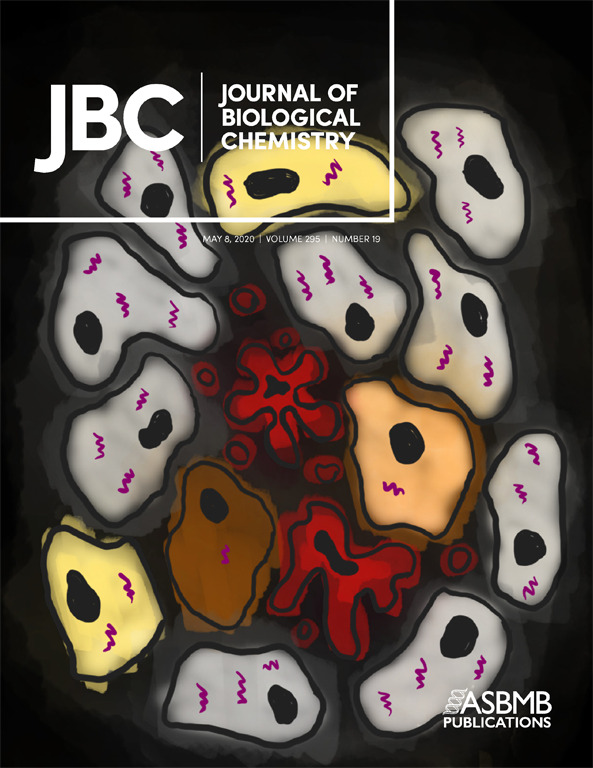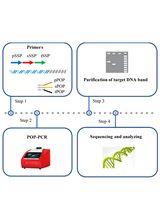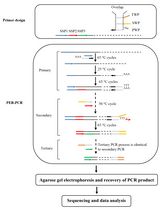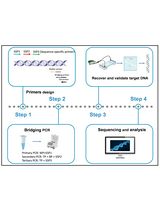- EN - English
- CN - 中文
Preparation and Characterization of Internally Modified DNA Templates for Chemical Transcription Roadblocking
用于化学转录障碍的内部修饰 DNA 模板的制备和特征分析
发布: 2021年09月05日第11卷第17期 DOI: 10.21769/BioProtoc.4141 浏览次数: 3515
评审: Andrew SavinovTatiana MishaninaLionel Schiavolin
Abstract
Site-specific transcription arrest is the basis of emerging technologies that assess nascent RNA structure and function. Cotranscriptionally folded RNA can be displayed from an arrested RNA polymerase (RNAP) for biochemical manipulations by halting transcription elongation at a defined DNA template position. Most transcription “roadblocking” approaches halt transcription elongation using a protein blockade that is non-covalently attached to the template DNA. I previously developed a strategy for halting Escherichia coli RNAP at a chemical lesion, which expands the repertoire of transcription roadblocking technologies and enables sophisticated manipulations of the arrested elongation complexes. To facilitate this chemical transcription roadblocking approach, I developed a sequence-independent method for preparing internally modified dsDNA using PCR and translesion synthesis. Here, I present a detailed protocol for the preparation and characterization of internally modified dsDNA templates for chemical transcription roadblocking experiments.
Graphic abstract:
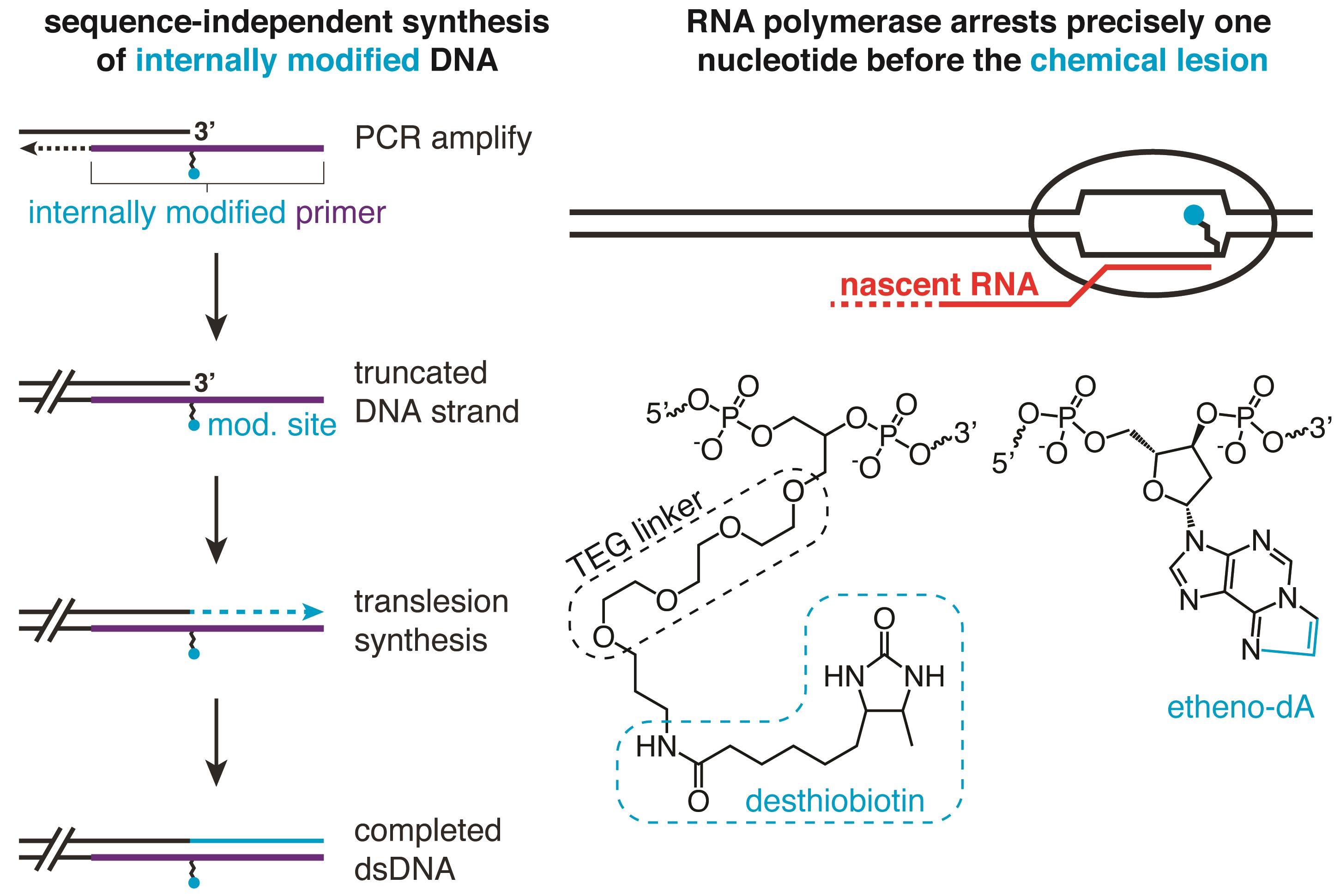
Precise transcription roadblocking using functionalized DNA lesions
Background
RNA begins to fold as it emerges from an RNA polymerase (RNAP) during transcription (Pan and Sosnick, 2006). Our ability to investigate the biological roles of nascent RNA structure and function therefore depends on the development of tools that can assess RNA cotranscriptionally. One successful approach towards this goal has been to leverage the extraordinary stability of the ternary RNAP-DNA template-nascent RNA complex to measure and manipulate nascent RNA in the context of arrested transcription elongation complexes (TECs) (Buenrostro et al., 2014; Tome et al., 2014; Watters et al., 2016; Strobel et al., 2017; Widom et al., 2018).
Multi-subunit RNAPs are remarkably processive enzymes that are capable of transcribing multi-kilobase operons in bacteria and tens of kilobases to megabases in eukaryotic genes (Core et al., 2008; Belogurov and Artsimovitch, 2019). The molecular forces that enable processive transcription elongation (Korzheva et al., 2000; Vassylyev et al., 2007a and 2007b) also render TECs notoriously resistant to dissociation in general. For example, when RNAP encounters a roadblock, such as a DNA-bound protein or a chemical DNA lesion, the TEC typically remains intact until either the roadblock is removed or a termination factor evicts RNAP from the DNA (Selby and Sancar, 1993 and 1994). When constructed in vitro by halting RNAP at a transcription roadblock, arrested TECs persist for exceptionally long periods of time. RNAP arrest by transcription roadblocking has consequently become the method of choice for structural and functional studies that require the display of nascent RNA molecules.
The development of high-throughput methods that use arrested RNAPs to display RNA underscores the need for versatile transcription roadblocking tools. Several roadblocking strategies that halt transcription elongation by colliding RNAP with a DNA-bound protein blockade have been developed: Sequence-specific protein roadblocks, such as the catalytically inactive EcoRIE111Q mutant (Pavco and Steege, 1990) and the E. coli DNA replication terminator Tus (Tome et al., 2014), are attached to a DNA template by their respective recognition sequences. Streptavidin can be stably attached to template DNA using precisely (Frieda and Block, 2012) or randomly positioned (Strobel et al., 2017) biotin modifications. dCas9 can be reversibly loaded onto arbitrary DNA sequences to halt RNAP sequentially at multiple DNA positions (Widom et al., 2019). In contrast to the abundance of approaches for protein-mediated transcription roadblocking, methods for halting RNAP at DNA lesions have been conspicuously lacking despite the long-established fact that DNA damage causes transcription arrest. I previously addressed this technological gap by developing a sequence-independent method for preparing internally modified linear dsDNA using translesion synthesis and characterizing the transcription roadblocking properties of several DNA modifications (Strobel et al., 2020).
My chemical transcription roadblocking method complements the properties of protein-mediated roadblocking strategies in several ways. First, like biotin-streptavidin roadblocking, chemical transcription roadblocking is sequence-independent and therefore compatible with the preparation of complex sequence libraries. Second, chemical stall sites are fully functional in a minimal in vitro transcription reaction and are therefore compatible with diverse experimental conditions. Third, functionalized chemical stall sites can enable TEC manipulations that are not otherwise possible. For example, I previously showed that TECs that are arrested at a desthiobiotin stall site can be enriched by exclusion from streptavidin-coated magnetic particles. The primary disadvantage of chemical transcription roadblocking is that E. coli RNAP can bypass some DNA lesions over time. Nonetheless, in many cases, lesion bypass is extremely slow and will therefore not be prohibitive for most experiments: in the transcription reactions described below, TECs remain at a desthiobiotin-TEG stall site with a half-life of ~600 min, whereas unimpeded bacterial transcription occurs at 50-100 nt/s. Furthermore, these arrested TECs can persist stably for hours following nucleotide depletion (Strobel et al., 2020).
Here, I provide a detailed protocol for the preparation and characterization of internally modified linear dsDNA templates for chemical transcription roadblocking. I first describe considerations that must be taken into account during oligonucleotide design and provide a set of validated sequences for PCR amplification. I then present a straightforward protocol for the preparation of internally modified DNA using PCR and translesion synthesis and describe how to assess DNA template quality using denaturing and native polyacrylamide gel electrophoresis. Lastly, I present a single-round in vitro transcription protocol that can be used to verify the transcription roadblocking activity of the DNA template. Together, these protocols will enable any researcher with basic molecular biology expertise to successfully design and prepare internally modified DNA templates for the display of nascent RNA from arrested TECs.
Materials and Reagents
Consumables
Low retention 10 μl pipette tips (e.g., Neptune Scientific, catalog number: 2342S3.S)
Low retention 200 μl pipette tips (e.g., Neptune Scientific, catalog number: 2102.S)
Low retention 1,000 μl pipette tips (e.g., Neptune Scientific, catalog number: 2372.S)
200 μl, 0.4 mm flat gel loading pipette tips (e.g., Laboratory Product Sales, catalog number: L113761)
Nuclease-Free 1.7 ml Microcentrifuge Tubes (e.g., Thomas Scientific, catalog number: 1149K01)
Nuclease-Free 2.0 ml Microcentrifuge Tubes (e.g., VWR, catalog number: 20170-170)
2.0 ml Screw-Cap Tubes, w/ O-ring (e.g., Laboratory Product Sales, catalog number: L233226)
0.2 ml 8-Strip PCR tube w/ dome cap (e.g., Laboratory Product Sales, catalog number: L216380)
QubitTM Assay Tubes (InvitrogenTM, catalog number: Q32856)
15 ml Conical Tubes (e.g., Laboratory Product Sales, catalog number: TR2000)
20 ml Conical Tubes (e.g., Laboratory Product Sales, catalog number: TR2003)
5 ml serological pipette (e.g., Laboratory Product Sales, catalog number: L310500)
10 ml serological pipette (e.g., Laboratory Product Sales, catalog number: L311000)
25 ml serological pipette (e.g., Laboratory Product Sales, catalog number: L312510)
Weigh boats (any source)
10 ml Syringe (e.g., BD, catalog number: 302995)
60 ml Syringe (e.g., BD, catalog number: 309653)
20G 1½” Needle (e.g., BD, catalog number: 305176)
0.2 μm Polyethersulfone (PES) syringe filter, sterile (e.g., VWR catalog number: 28145-501)
150 mm Culture Dish (e.g., Corning® catalog number: 430599)
Small 1-Ply Light-Duty Tissue Wipers (e.g., VWR, catalog number: 82003-820)
Large 1-Ply Light-Duty Tissue Wipers (e.g., VWR, catalog number: 82003-822)
Plastic-backed bench paper (e.g., Fisher Scientific, catalog number: 14-127-47)
Nitrile Gloves
Vaseline® Petroleum Jelly Original
Rain-X® Original Glass Water Repellent
Large binder clips (e.g., Staples 2” Binder Clips, Staples, catalog number: 10669)
AEP 30510400 ZipSafe Sealwrap, 18” × 2000’ (Amazon)
Razor blades
Aluminum foil
Dish soap
Plastic brush for cleaning sequencing gel plates
Reagents
Note: Chemicals should be Molecular Biology/Biotechnology Grade.
Nuclease-Free Water (e.g., InvitrogenTM, catalog number: 10977015), store at room temperature (RT)
Milli-Q Water, store at RT
Deionized Water, store at RT
Diethyl pyrocarbonate (DEPC), >97%, (Thermo ScientificTM, AAJ14710AC), store at -20°C
Note: Handle DEPC in a chemical fume hood.
Tris (1 M), pH 8.0, RNase-free (InvitrogenTM, catalog number: AM9855G), store at RT
EDTA (0.5 M), pH 8.0, RNase-free (InvitrogenTM, catalog number: AM9260G), store at RT
Potassium Chloride (KCl) (2 M), RNase-free (InvitrogenTM, catalog number: AM9640G), store at RT
Magnesium Chloride (MgCl2), 1 M, RNase-free (InvitrogenTM, catalog number: AM9530G), store at RT
Sodium Acetate (NaOAc) (3 M), pH 5.5 RNase-free (InvitrogenTM, catalog number: AM9740), store at RT
1× Tris-EDTA (TE) Solution (10 mM Tris pH 7.5, 0.1 mM EDTA), (e.g., Integrated DNA Technologies, catalog number: 11-05-01-05), store at RT
Tris Base (e.g., VWR, catalog number: 97061-794), store at RT
EDTA, Disodium Salt, Dihydrate (e.g., InvitrogenTM, catalog number: 15576028), store at RT
Hydrochloric Acid (HCl) (e.g., Sigma-Aldrich, catalog number: 320331), store at RT with other acids beneath a fume hood.
Caution: Hydrochloric acid is highly corrosive and must be handled in a chemical fume hood.
Sodium hydroxide (NaOH) (e.g., Sigma-Aldrich, catalog number: S8045), store at RT with other bases
Caution: Sodium hydroxide is highly corrosive.
Boric Acid (e.g., Fisher Scientific, catalog number: BP168-500), store at RT
Sodium dodecyl sulfate sodium salt (SDS) (e.g., Millipore, catalog number: 7910-500GM), store at RT
Dithiothreitol (DTT) (e.g., Gold Biotechnology, catalog number: DTT100), store desiccated at -20°C
100% Ethanol (200 Proof) (e.g., Decon Labs, catalog number: 2716), store at RT
Isopropanol (e.g., Sigma-Aldrich, catalog number: I9516-4L), store at RT
Glycerol (e.g., Sigma-Aldrich, catalog number: G5516-4L), store at RT
Phenol:Chloroform + Tris Buffer (e.g., Thermo ScientificTM, catalog number: 17909), store at 4°C
Caution: Phenol:chloroform should be handled in a chemical fume hood.
OmniPur Formamide, Deionized (e.g., Millipore, catalog number: 4650-500ML), store at 4 °C
Caution: Formamide should be handled in a chemical fume hood.
Dimethyl sulfoxide (DMSO) (e.g., Fisher Scientific, catalog number: D128-500), store at RT
Caution: Dimethyl sulfoxide should be handled in a chemical fume hood.
Ammonium persulfate (APS) (e.g., Sigma-Aldrich, catalog number: A3678-100G), store at RT
TEMED (Tetramethylethylenediamine) (e.g., Bio-Rad, catalog number: 1610801), store at RT
Bromophenol blue (e.g., Bio-Rad, catalog number: 1610404), store at RT
Xylene cyanole FF (e.g., Bio-Rad, catalog number: 1610423), store at RT
Ethidium bromide, 10 mg/ml (e.g., InvitrogenTM, catalog number: 15585011), store at RT
Note: Handle ethidium bromide in accordance with institutional guidelines.
Quick-Load® Purple 100 bp DNA Ladder (New England Biolabs, catalog number: N0551L), store at RT
Low Range ssRNA Ladder (New England BioLabs, catalog number: N0364S), store at RT
SYBR Gold Nucleic Acid Stain (InvitrogenTM, catalog number: S11494), store at -20°C
Deoxynucleotide (dNTP) Solution Mix (New England Biolabs, catalog number: N0447L), store at -20°C
dNTP Set (100 mM) (InvitrogenTM, catalog number: 10297018), store at -20°C
2-Amino-dATP (TriLink Biotechnologies, catalog number: N-2003), store at -20°C
5-Propynyl-dCTP (TriLink Biotechnologies, catalog number: N-2016), store at -20°C
High Purity rNTP Set, 100 mM Solutions (ATP, CTP, GTP, UTP) (Cytiva Life Sciences, catalog number: 27202501), store at -20°C
UltraPureTM BSA (InvitrogenTM, catalog number: AM2616), store at -20°C
Rifampicin (Gold Biotechnology, catalog number: R-120-10), store dessicated at -20°C
GlycoBlueTM Coprecipitant (InvitrogenTM, catalog number: AM9516), store at -20°C
QubitTM dsDNA HS Assay Kit (InvitrogenTM, catalog number: Q32854), some components stored at 4°C
QubitTM dsDNA BR Assay Kit (InvitrogenTM, catalog number: Q32853), some components stored at 4°C
SeaKem GTGTM Agarose (Lonza, catalog number: 50074), store at RT
Critical: Agarose must be preparatory grade.
UreaGel 19:1 Denaturing Gel System (National Diagnostics, catalog number: EC-833), store at RT
Caution: Contains acrylamide. Acrylamide is a neurotoxin and should be handled cautiously.
ProtoGel (30%) (National Diagnostics, catalog number: EC-890), store at RT
Caution: Contains acrylamide. Acrylamide is a neurotoxin and should be handled cautiously.
QIAquick PCR purification kit (Qiagen, catalog number: 28106), store at RT
QIAquick Gel Extraction Kit (Qiagen, catalog number: 28706), store at RT
Internally modified oligonucleotides (Integrated DNA Technologies, see Table 1)
UTP, [α-32P]-3000 Ci/mmol 10 mCi/ml (PerkinElmer, catalog number: BLU007H), store at -20°C
Note: [α-32P]-UTP must be handled in accordance with institutional radiation safety protocols.
Enzymes
Q5® High-Fidelity DNA Polymerase (New England Biolabs, catalog number: M0491L), store at -20°C
Vent® (exo-) DNA Polymerase (New England Biolabs, catalog number: M0257L), store at -20°C
Sulfolobus DNA Polymerase IV (New England Biolabs, catalog number: M0327S), store at -20°C
Thermolabile exonuclease I (New England Biolabs, catalog number: M0568L), store at -20°C
E. coli RNA Polymerase Holoenzyme (New England Biolabs, catalog number: M0551S), store at -20°C
Note: E. coli RNA polymerase core and 70 can be purified by well-established protocols (Marr and Roberts, 1997; Svetlov and Artsimovitch, 2015) and used to reconstitute the holoenzyme.
Prepared Solutions (see Recipes section)
DEPC-Treated Milli-Q Water
10 mM Tris-HCl, pH 8.0
10 mM Thermostability-enhancing dNTP Solution
1× Tris-Borate-EDTA Buffer
70% Ethanol
10% SDS
6× DNA Loading Dye (+SDS, XC only)
10% APS
1× Formamide Loading Dye
3× Tris-Borate-EDTA Buffer
6× DNA Loading Dye (non-denaturing)
1 M DTT
100 mM DTT
10× Transcription Buffer
20× NTP Solution
5 mg/ml BSA
2 mg/ml Rifampicin
1 M Tris-HCl, pH 8.0
0.5 M EDTA, pH 8.5
Stop Solution
Equipment
Autoclave
Fume Hood
-20°C and -80°C freezers (any source)
Refrigerator (4°C) (any source)
2 μl, 20 μl, 200 μl, and 1,000 μl micropipettes (any source)
Pipette Controller (e.g., Drummond, catalog number: 4-000-101)
Plastic tube racks for 1.7 ml, 15 ml, and 50 ml tubes (any source)
Lab Timer (e.g., Traceable®, catalog number: 5004CC)
Ice bucket (e.g., SCIENCEWARE®, catalog number: M16807-4002)
Erlenmeyer flasks (500 ml, 4 L) (any source)
Beakers (1 L, 2 L) (any source)
Autoclavable media bottles (500 ml, 1 L, and 2 L) (any source)
Graduated cylinders (10 ml, 50 ml, 200 ml, 0.5 L, 1 L, and 2 L) (any source)
Plastic 250 ml beaker (any source)
4 L polypropylene bottle (any source)
20 L carboy (any source)
Microwave (any source)
Vortex (e.g., Scientific Industries, catalog number: SI-0236)
Thermal cycler (e.g., Bio-Rad S1000 w/ 96-Deep Well Reaction Module, catalog number: 1852197)
Critical: 100 μl PCRs require a deep well thermal cycler. If 100 μl exceeds the maximum sample volume of your thermal cycler, aliquot the reaction into additional PCR tubes.
Refrigerated microcentrifuge (e.g., Eppendorf 5424 R, catalog number: 5406000046)
Mini centrifuge (e.g., VWR, catalog number: 76269-064)
Digital Dry Bath (e.g., Thermo ScientificTM, catalog number: 88870001)
Lab ArmorTM Beads (GibcoTM, catalog number: A1254301)
Aluminum block for 1.7 ml tubes (e.g., Thermo ScientificTM, catalog number: 88880130)
Aluminum heating/block, holds 96 × 0.2 ml tubes (Sigma-Aldrich, catalog number: Z740270-1EA)
Analog thermometer (e.g., VWR, catalog number: 89095-600)
Digital thermometer (e.g., VWR, catalog number: 89094-750)
QubitTM 4 Fluorometer (InvitrogenTM, catalog number: Q33238)
Rocking platform (e.g., Corning, catalog number: 6703)
Rotator (e.g., ATR, Rotamix Rotator RKVSD and end-over end rod, catalog numbers: 10101 and 10110)
pH meter (e.g., Mettler Toledo, S220-Bio, catalog number: 30019031)
Critical: The pH meter electrode must be compatible with Tris solutions.
Balance (e.g., Ohaus, catalog number: 30253007RM)
Analytical balance (e.g., Mettler Toledo, catalog number: 30029076)
Flat Spatula (e.g., VWR, catalog number: 82027-532)
Weighing Spatulas (any source)
Stir Plate (e.g., Corning PC-610D, catalog number: 6795620D)
Magnetic stir bars (e.g., VWR, catalog number: 58948-025)
Horizontal Gel Apparatus (e.g., Horizon 11-14 Midi Gel System, Gel Company, HZ1114)
Note: Comb should hold at least 50 μl.
Mini-PROTEAN Tetra Cell, 2-gel, for 1.0 mm handcast gels (Bio-Rad, catalog number: 1658003FC)
Sequencing Gel Apparatus (e.g., BRL Model S2; Gel Company, catalog number: S2-3040)
Note: Spacers and comb should be 0.4 mm thickness.
Basic power supply (e.g., Bio-Rad, catalog number: 1645050)
High voltage power supply (e.g., Bio-Rad, catalog number: 1645056)
UV Transilluminator (e.g., UVP catalog number: UV95045901)
Caution: Never expose eyes or skin to UV radiation.
Dark Reader Blue light Transilluminator (Clare Chemical, catalog number: DR89X)
Cardboard exposure cassette (e.g., Sigma-Aldrich, catalog number: E-9135, discontinued)
Storage Phosphor Screen, 35 × 43 cm (Cytiva Life Sciences, catalog number: 28956476)
Storage Phosphor Screen Image Eraser (Cytiva Life Sciences, catalog number: 29187190)
Typhoon Biomolecular RGB Biomolecular Imager (Cytiva Life Sciences, catalog number: 29187194)
Acrylic shielding for high-energy beta radiation
Note: I have found the items below useful when performing experiments with 32P.
Vertical Bench-Top Beta Shield, 3/8” Thick (e.g., RPI, catalog number: BR-201)
24-place Beta Block (e.g., Laboratory Product Sales, catalog number: 172644)
Sample Beta Box w/ ice compartment (e.g., Fisher Scientific, catalog number: S29137)
Acrylic Waste Box (e.g., ThermoScienticTM, catalog number: 67459024)
Large Vertical Acrylic Shield (Denville Scientific, catalog number S0260-S)
Medium Vertical Acrylic Shield (Denville Scientific, catalog number S0180-S)
Large Acrylic Storage Container (e.g., Mitchell Plastics, catalog number: RP-400)
Small Acrylic Storage Container (e.g., IBI Scientific, catalog number: RB-100)
Pipette tip disposal box (Thomas Scientific, catalog number: 1216J05)
Procedure
文章信息
版权信息
© 2021 The Authors; exclusive licensee Bio-protocol LLC.
如何引用
Readers should cite both the Bio-protocol article and the original research article where this protocol was used:
- Strobel, E. J. (2021). Preparation and Characterization of Internally Modified DNA Templates for Chemical Transcription Roadblocking. Bio-protocol 11(17): e4141. DOI: 10.21769/BioProtoc.4141.
- Strobel, E. J., Lis, J. T. and Lucks, J. B. (2020). Chemical roadblocking of DNA transcription for nascent RNA display.J Biol Chem 295(19): 6401-6412.
分类
分子生物学 > DNA > PCR
分子生物学 > RNA > 转录
您对这篇实验方法有问题吗?
在此处发布您的问题,我们将邀请本文作者来回答。同时,我们会将您的问题发布到Bio-protocol Exchange,以便寻求社区成员的帮助。
Share
Bluesky
X
Copy link


